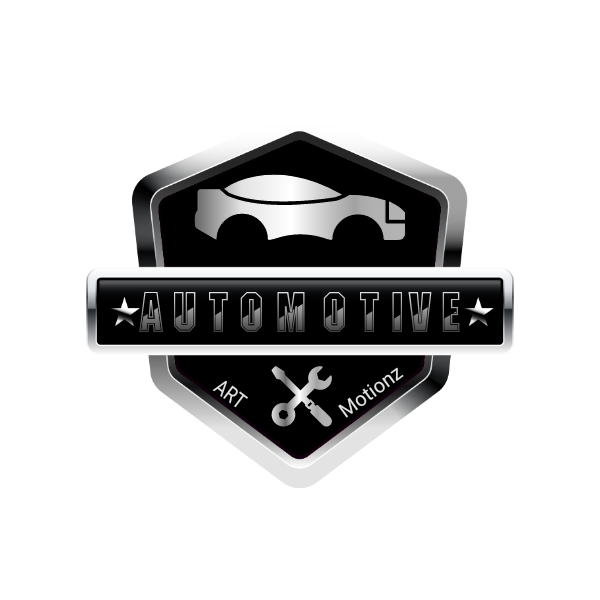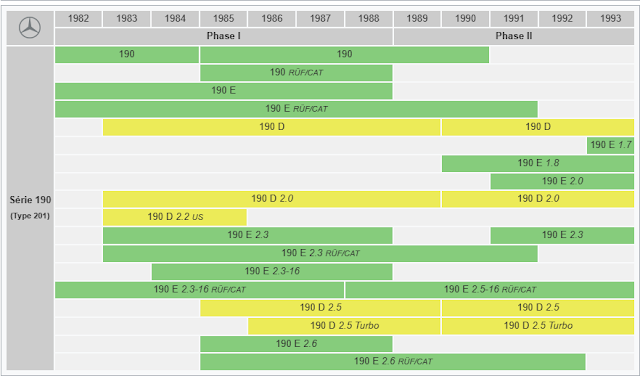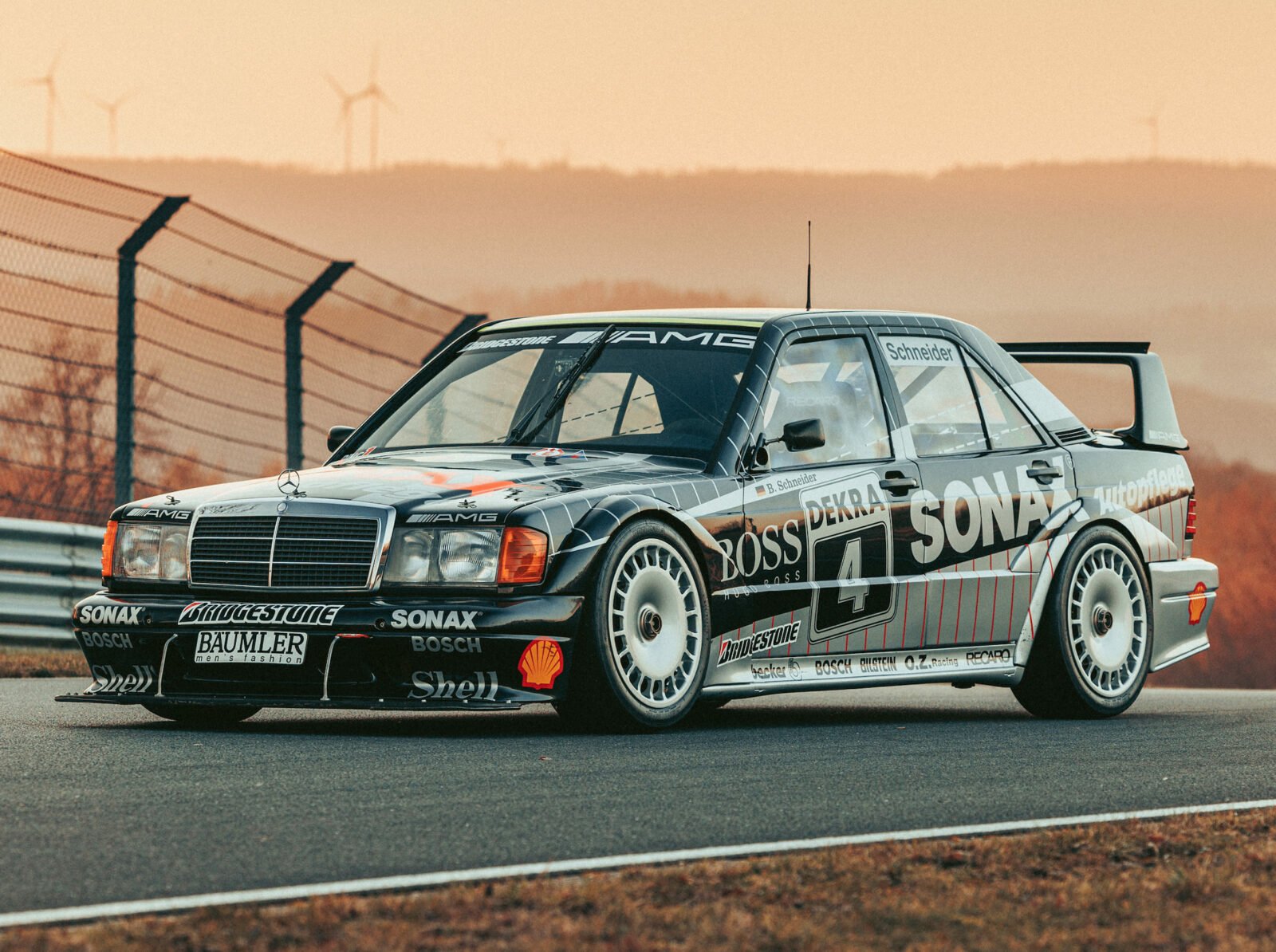Back to the future: Mercedes-benz W201 190
Baby Benz !
The Mercedes-Benz W201, commonly known as the Mercedes 190 series, is a compact class sedan featuring a front-engine, rear-wheel-drive layout. It accommodated five passengers within its four-door configuration and was produced from 1982 to 1993, marking Mercedes-Benz's initial foray into the compact car segment.
The vehicle was designed by Bruno Sacco, who led Mercedes-Benz styling from 1975 until 1999, and made its first appearance at the 1982 Paris Motor Show. The W201 was assembled at the Bremen and Sindelfingen plants in Germany, with a total production of 1,879,629 units over its eleven years.
This model introduced several advanced features for its time, including a pioneering 5-link rear suspension later adopted by E and C class models, as well as front and rear anti-roll bars, anti-dive and anti-squat geometry. It also came equipped with airbags, ABS brakes, and seatbelt pretensioners. The use of lightweight, high-strength steel in its construction allowed it to endure a concrete barrier offset crash at 35 mph (56 km/h) with minimal cabin deformation and no serious injuries to passengers.
In 1983, Mercedes-Benz unveiled a high-performance version, the 190 E 2.3-16V, at the Frankfurt Motor Show.
Historical Context
The development of the W201 spanned almost eight years, from January 1974 to its debut in December 1982, with Mercedes-Benz investing over £600 million in its research and development. This investment led to a vehicle described as 'massively over-engineered'.
Testing of early prototypes began in 1978, with the final design approved on March 6, 1979. Pilot production kicked off in February 1982 after the completion of engineering tests. The W201-based 190 was officially unveiled on December 8, 1982, and launched in Germany the following day. It was introduced to the UK market in right-hand drive format in September 1983.
When initial obstacles halted the production of the W201 in Bremen, manufacturing commenced in Sindelfingen with an annual capacity of 140,000 units. Eventually, issues were resolved, allowing Bremen to take over production from its commercial operations.
The 190 E model (E denoting Einspritzung, or Fuel Injection) utilized the Bosch KE-Jetronic Multi-Point Fuel Injection system to manage fuel delivery, unlike the carbureted versions of the 190 models. With their advanced fuel injection systems and larger intake and exhaust valves, the 190 E models produced more power than their non-fuel injected counterparts. By April 1990, the carbureted 190 was phased out and replaced by a more efficient, fuel-injected 1.8-liter model at the entry level of the lineup.
In 1991, the W201 underwent subtle exterior updates, including door frames that were painted to match the body color instead of the previous anodized black finish. The production of the last Mercedes-Benz 190E concluded on May 17, 1993.
Petrol models
Mercedes 190 E
In 1982, the initial offerings comprised the 190 and 190 E models, both featuring the M102 1,997 cc (2.0 L) inline-4 engine. The 190 boasted an M102.921 engine generating 90 PS (66 kW; 89 hp), while the 190 E sported an M102.962 engine delivering 120 PS (88 kW; 118 hp). Subsequently, in September 1983, the 190 E 2.3 (2,299 cc) debuted exclusively for the North American market (later available in other regions), equipped with the M102.961 engine producing 113 hp (84 kW; 115 PS). This power reduction was necessitated by the emissions standards prevailing in North America at the time. Engine refinements in 1984, including enhancements to the intake manifold, camshaft, and fuel injection system, resulted in an output of 122 PS (90 kW; 120 hp). Concurrently, the carbureted 190 received an upgrade in 1984, raising its power output to 105 PS (77 kW; 104 hp). The introduction of the 2.3-16 "Cosworth" variant also occurred in 1984.
By 1985, the 190 E 2.3 featured the M102.985 engine, delivering 132 PS (97 kW; 130 hp) until its revision in 1987. The updated version incorporated the Bosch KE3-Jetronic Injection system, a different ignition system, and a higher compression ratio, resulting in an output of 136 PS (100 kW; 134 hp).
At the Frankfurt International Motor Show in September 1985, the first 190 equipped with an inline-six engine made its debut. The 190 E 2.6, equipped with the M103.940 engine, achieved a maximum power output of 160 PS (118 kW; 158 hp) with a catalytic converter and 166 PS (122 kW; 164 hp) without. In the North American market, the 190 E 2.6 remained available until 1993, coinciding with the conclusion of the W201's production. From 1992 to 1993, the 2.6 was offered as a special "Sportline" model, featuring upgraded suspension and interior elements. The 190 E 2.3 was sold until 1988, followed by a brief hiatus before its reintroduction from 1991 to 1993.
In 1990, Mercedes-Benz phased out the carburetor-equipped 190, introducing the fuel-injected 190E 1.8. This model featured a 1,797 cc (1.8 L) M102.910 engine with the same bore but a shorter stroke than the M102.962, producing identical power output of 80 kW (109 PS; 107 hp) as the outgoing 190 model, albeit with slightly lower torque at 150 N⋅m (111 lbf⋅ft).
Diesel Variants
Mercedes 190 D
The 190 D came with a choice of three distinct engines. The base engine was a 2.0 L inline-four, which was never marketed in North America. In September 1983, a 2.2-liter version, boasting the same power output as the 2.0 L, was introduced, available only during the model years 1984 and 1985 and solely in the US and Canada. Towards the late 1980s and early 1990s, a 2.5 L inline-five engine became available. Additionally, the 2.5 L Turbo engine, initially offered in mainland Europe and excluded from the UK market for several years, was briefly accessible to American consumers in 1987 and has since become somewhat of a collector's item. Notably, the exterior of the 2.5 Turbo model differs from other variants, featuring fender vents on the front passenger side fender designed to supply air to the turbocharger.
The different versions
Limited Editions
190 LE
For the 1993 model year, a special edition of the 190 was crafted exclusively for the UK and Irish markets, known as the 190LE. Although badged as 190 E on the rear boot lid, with LE on the right-hand side, approximately 1,000 units were manufactured, each accompanied by a large A3-sized certificate, uniquely numbered.
Available solely in three colors—Azzuro Blue, Brilliant Silver, and Rosso Red—the Azzuro blue variants boasted a grey checked cloth interior, while the silver ones featured a black checked cloth interior, and the Rosso Red models came with a biscuit/cream checked cloth interior.
Equipped with additional features that were optional on other models, the LE came with either a 1.8 or 2.0-liter engine. Both versions included a standard electric tilt and slide steel sunroof, four electric windows, electric aerial, 8-hole alloy wheels, Blaupunkt Verona CR43 Radio/cassette player, and walnut wood trim. The 2.0-liter model also featured rear headrests and a front armrest. Surprisingly, the LE was priced nearly £3,500 lower than the 1.8-liter model and £2,000 cheaper than the 2.0-liter model, despite identical specifications.
180 E
From October 1991 to March 1994, a limited run of 180 E Limited Edition cars was available in Australia. Essentially a 1.8-liter 190 E with basic trim, this model was priced at A$45,450 upon launch, significantly less than the 190 E at A$63,200. Achieving this lower price involved removing various equipment and offsetting import duties through the use of Australian-made components.
190 E Limited Edition
In 1993, the U.S. market saw the introduction of two LE models, limited to 1,400 units each: the 190 E 2.3 LE and the 190 E 2.6 LE. Distinguished by a rear badge deletion, these models featured unique specifications. The 2.3 LE was offered only in Emerald Green, while the 2.6 LE was available solely in Black. Notably, the 2.3 LE boasted cream beige leather upholstery, burl walnut trim, fully electric front seats, and other luxurious touches. Conversely, the 2.6 LE, dubbed the Black Sportline, showcased Recaro seats with red inserts, carbon fiber trim, and a Sportline tuned suspension for enhanced performance.
Evolution Models
Evolution I
Introduced at the Geneva Auto Show in March 1989, the 190 E 2.5-16 Evolution aimed to enhance the competitive edge of the 2.5-16 model. Sporting a new rear spoiler, wider wheel arches, and numerous under-the-skin enhancements such as brakes and suspension upgrades, the Evo I featured an adjustable suspension system, improving its track performance. With similar power output to the standard 2.5-16, the Evo I showcased a redesigned engine with a shorter stroke and bigger bore, resulting in improved power generation.
Evolution II
Unveiled at the Geneva Auto Show in March 1990, the 190 E 2.5-16 Evolution II represented the pinnacle of the 190 series. With all 502 units sold before its debut, the Evo II featured a short-stroke 2.5-liter engine and a full SLS adjustable suspension system. Sporting a radical body kit designed for aerodynamic efficiency, including a large adjustable rear wing and rear window spoiler, the Evo II boasted a maximum power output of 235 PS and a torque of 245 N⋅m, making it a true collector's item.
AMG Models
When the 190 was initially produced, AMG operated independently from Mercedes-Benz as a racing and tuning company. Drawing from their DTM racing experience, AMG tuned various factory petrol engines, including the 190 E, enhancing their performance by adding 25 hp (19 kW; 25 PS) over the standard models. Additionally, they introduced aerodynamic enhancements such as rear spoilers and front splitters to improve high-speed stability, along with alloy wheels and leather interiors.
190 E 3.2 AMG
The 190 E 3.2 AMG marked the first model sold through AMG authorized resellers with a Mercedes-Benz new car warranty. Approximately 200 complete cars were manufactured, available in black or silver at a considerable price (around DM 155,780). Alongside the complete 190 E 3.2 AMG units, Mercedes-Benz also offered AMG body kits and 3.2 L AMG engines separately, leading to some 190 models being fitted with these features either at the factory or retrofitted. Equipped with a straight-six 12-valve engine, the 190 E 3.2 AMG boasted a maximum power output of 231 hp (172 kW; 234 PS), achieving a top speed of 243 km/h (151 mph).
Mercedes 190 D BlueEFFICIENCY (2009)
The 190 D BlueEFFICIENCY served as an experimental vehicle demonstrating advancements in diesel engine technology over the past two decades. Based on a 1988 190 E 2.6, it was equipped with a Mercedes-Benz OM651 engine, delivering a power output of 204 PS (150 kW; 201 hp) and 500 N⋅m (369 lb⋅ft) of torque. Accelerating from 0 to 100 km/h in 6.2 seconds, it achieved a fuel efficiency of 4.9 liters per 100 kilometers (NEDC), compared to the original car's 7.3 liters per 100 kilometers. Despite being 385 kg heavier and larger in dimensions than the modern C 250 CDI BlueEFFICIENCY, the 190 D BlueEFFICIENCY showcased superior fuel efficiency.
Mercedes-Benz 190 E Elektro (1990)
The 190 E Elektro represented a limited series of fully electric variants of the Mercedes-Benz W201. Initially revealed at the Hannover Fair in May 1990, it aimed to explore different drive configurations and battery packs using the 190E platform. The electric variant retained the cabin space and safety features of the regular ICE model. Featuring sodium-nickel chloride or sodium-sulphur batteries, it offered a driving range of 110 km (68 miles) on a full charge. Mercedes conducted a large-scale field trial on the German island of Rügen between 1992 and 1996 to assess electric cars and their powertrains in everyday conditions, showcasing excellent reliability and performance.
Stay tuned ! And don't miss our INSTAGRAM for more cars content :ARTmotionzAuto










